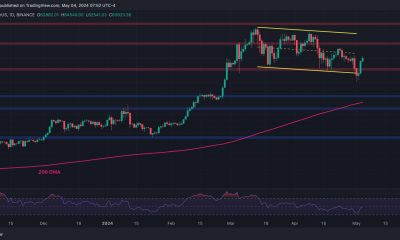Cryptocurrency
7 Best Solana (SOL) Wallets: Full Comparison (Updated 2024)
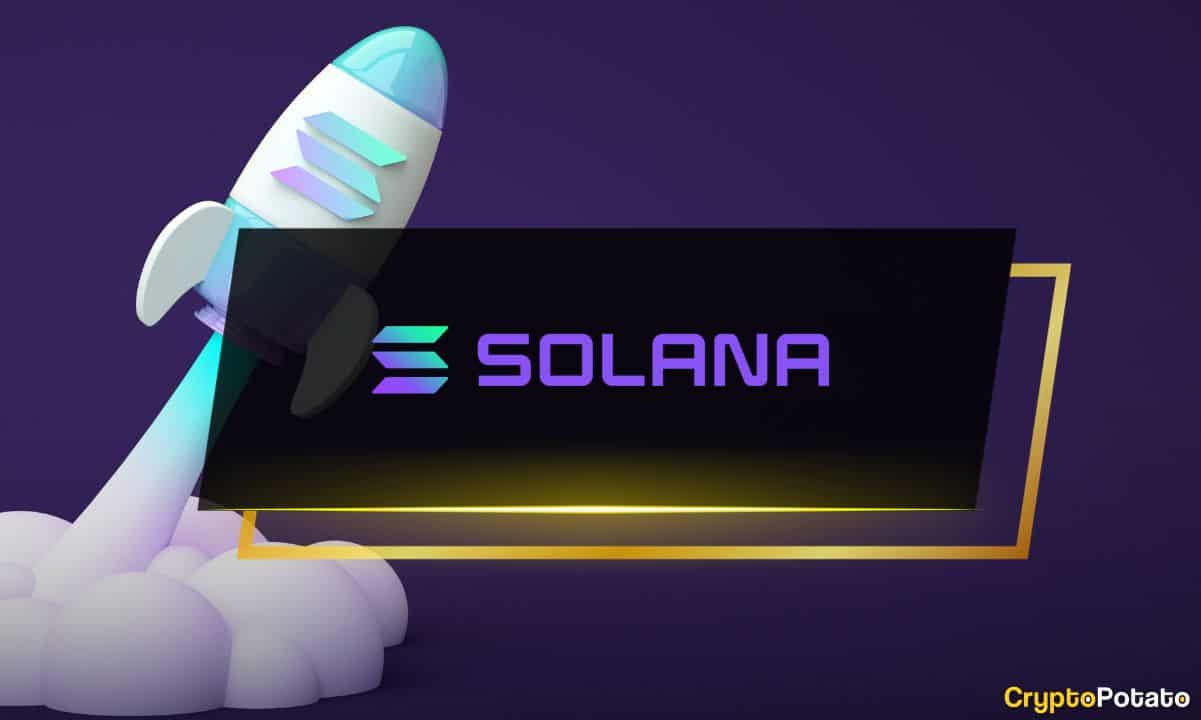
Solana is one of the largest blockchain ecosystems, boasting thousands of decentralized applications. With a vast sea of web3 projects and apps on Solana waiting to be explored, it’s crucial that we pick the right wallet that suits our needs.
Whether you’re a seasoned user or a newcomer to Solana’s blockchain ecosystem, finding the best Solana wallet (tailored to your needs) is crucial. This guide explores some of the most popular options, as well as their pros, cons, distinctive benefits, and what you should be aware of before creating your new address.
Before we dive deeper, however, if you want to find out more about the network and its ecosystem, take a look at our comprehensive Solana blockchain guide.
Without any further ado, let’s take a look at the best Web3 wallets for Solana.
Comparison of the Best Web3 Wallets for Solana
Phantom – The Most Popular Choice
Phantom is the most popular Solana wallet in terms of user base (as of writing these lines) — thanks to its multi-purpose design, user-friendly interface, high performance, and low gas fees.
This non-custodial wallet is popular among SOL stakers due to its simplified staking process and user-friendly interface. This makes it a preferred choice for over half a million monthly users. It’s available as a web browser extension for Brave, Firefox, and Chrome — and it’s also available on mobile.
The mobile version is intuitive, allowing users to tab between their funds, non-fungible tokens (NFTs), swap functions, settings, and more. Phantom is a solid choice due to its beginner-friendly and straightforward interface.
However, that doesn’t mean the wallet is simplistic:
- Storing: SOL, Solana NFTs, and SLP tokens (which mean Solana Program Library, a token standard for building fungible and on-fungible tokens using Solana smart contracts, similar to Ethereum’s ERC-20.)
- Swapping: Phantom provides instant swaps with 0.85% transaction fees (keep in mind this is a flat fee) thanks to an integration with the Automated Market Maker (AMM) Raydium.
- Staking SOL by selecting a validator to stake your tokens with. You can check out StakeView to determine which Solana validators offer the best APY estimates.
- Cross-chain swapper: designed to bring liquidity from the Ethereum ecosystem, this feature supports all EVM tokens and bridges them to USDC, USDT, or DAI.
- Cold wallet integration with Ledger.
The cons? As with everything, there are some drawbacks to Phantom as well.
- Users have to spend a considerable time studying which validators to stake their tokens with. The most popular ones, while offering the highest APY, are often the most expensive.
Phantom key features summary:
- Staking: yes
- Swap: yes
- Interface: mobile, browser extension
- HD wallet integration: yes — Ledger
- Other chains supported: Ethereum and Polygon
Solflare – For The Most Experienced Users
Designed by Solana Labs, Solflare was one of the first wallets in the ecosystem alongside Phantom, with identical functionalities, such as token swapping, NFT storage, Ledger integration, and SOL staking. It’s accessible on Google Play, the App Store, and as a Chrome extension.
Despite being nearly identical to Phantom both on its web application and mobile version, Solflare presents some unique capabilities:
- Direct fund management thanks to an integration with the Solrise platform
- MetaMask integration for Solana dApps
- A 24-word mnemonic phrase for enhanced security.
- Besides supporting staking, swapping, and bridging operations, Solflare is compatible with Solana Pay, a payment network offering low-cost, fast transactions.
Solflare key features summary:
- Staking: yes
- Swap: yes
- Interface: mobile, browser extension
- HD wallet integration: yes — Ledger
- Other chains supported: no, but you can use the Solana Snap feature to connect Solflare to MetaMask and bridge assets from different blockchains
Atomic Wallet – Higher Yields, Higher Cost
Atomic Wallet stands out due to its high staking yields and a wide range of crypto assets — over 1000 coins available for buying, selling, staking, swapping, and earning rewards.
Staking rewards vary, with top performers like Cosmos, AWC, and Zilliqa throwing the highest yields. However, larger-cap coins like Cardano, Solana, and Ethereum remain the most popular staking options, with lower yields.
Those who wish to stake can find out more about it in this guide.
All crypto purchases on Atomic are made through its parent Simplex, a centralized on-ramp fiat platform (which also means the user must complete a KYC). That said, here’s a breakdown of Atomic Wallet fees:
- Buying Cryptocurrencies: flat 5% fee (minimum $10) through Simplex
- Crypto transactions: no fees for incoming or outgoing transactions (except the network fee for blockchain transactions, paid to miners as for any other crypto transaction)
- Extra fees: none, but it does charge additional fees on swaps —0.5%. However, all swaps are facilitated through ChangeNow, meaning the user must also cover ChangeNow’s fees.
Moreover, Atomic Wallet allows users to store their NFTs from Ethereum, Solana, BNB Chain, Polygon, Avalanche, and Fantom.
As you may have noticed, Atomic’s main drawback is the fees — a 2% fee (minimum $10) on top of Simplex’s 5% fee. The second drawback is the lack of robust security features. The wallet only relies on a PIN or password for protection and a 12-word passphrase, and there is no support for multi-sig permissions, no integrations with cold wallets, and no Two-Factor Authentication (2FA).
Atomic Wallet key features summary:
- Staking: yes
- Swap: yes
- Interface: mobile, browser extension
- HD wallet integration: no
- Other chains supported: Over 30 blockchains, including popular networks such as Ethereum, Fantom, Arbitrum, Polygon, Binance Smart Chain, Avalanche, Aurora, and more.
Exodus
Exodus is a non-custodial and multi-functional wallet that works for Solana as well as many other networks.
The Solana Wallet Adapter is integrated with the Exodus Mobile app, allowing users to connect their Solana decentralized applications (dApps) to their wallets or access a vast sea of dApps from several blockchain ecosystems.
It is accessible on desktop, mobile, and browser applications, supporting functionalities like token staking and swapping. Exodus announced its support for Solana in late 2020, and all their desktop, mobile, and hardware crypto wallets inherently support the SOL token.
When utilizing Solana on Exodus, users can expect the following fees:
- Staking Fees: No fees for staking Solana, but a 0.00005 SOL fee for unstaking, deducted from the minimum balance.
- Solana Pay Fees: Transactions on Solana Pay have a low fee of 0.00005 SOL, equivalent to less than a penny.
- Exchange Fees: A small fee applies to cryptocurrency exchanges within the wallet, with the exact percentage unspecified.
Pro tip: unlike the other wallets, Exodus has its own staking validator called Everstake. This means staking assets is a more direct process instead of choosing between dozens of validators.
The cons: like other wallets, it uses a 12-word seed phrase and has no 2FA. In other words, more security measures equal more safety in the long run.
Exodus key features summary:
- Staking: yes
- Swap: yes
- Interface: mobile, desktop, browser extension
- HD wallet integration: yes — Trezor
- Other chains supported: Bitcoin, Ethereum, Binance Smart Chain, Polygon, Solana, and Cardano
Trust Wallet
Trust Wallet is one of the top-rated wallets in the market.
You won’t get bored with Trust Wallet as you can store and stake SOL to earn rewards through the Trust Wallet interface, as well as having full control of your assets.
Here’s what you can do with Trust Wallet:
- Staking SOL: Similar to other wallets, you’ll have to choose the amount and the validator you wish to stake your SOL with.
- Browse Solana dApps: Trust Wallet also supports several Solana dApps. This ranges from automated market makers, lenders, and yield farming apps such as Solend, Bonfida, Raydium, Jupiter, Marinade Finance, and more.
- Buy unique Solana-based NFTs and swap SLP tokens on the Solana network.
All said and done, Trust Wallet is a solid choice if you wish to store and stake your SOL while exploring the Solana ecosystem all in one wallet.
Trust Wallet key features summary:
- Staking: yes (earn yield using Trust Wallet on dApps)
- Swap: yes
- Interface: mobile, desktop, browser extension
- HD wallet integration: yes — Ledger
- Other chains supported: over 70+ blockchains supported, including Ethereum, Solana, Binance Smart Chain, and more.
MetaMask (Solflare Snap)
MetaMask is arguably the most popular self-custodial Web3 wallet in the industry, trusted by over 20 million users, but that doesn’t mean it supports every blockchain out there. When it comes to Solana, it’s important to note that MetaMask is incompatible right off the bat.
However, users can take advantage of Solana Snap for MetaMask. This is an isolated program that allows MetaMask users to manage their SOL tokens and NFTs while also gaining access to the Solana ecosystem of dApps.
In short, the program provides Solana-specific functionalities on the MetaMask wallet without needing multiple third-party wallets.
To install the Solana Snap for MetaMask, visit the Solflare MetaMask landing page and follow the steps.
MetaMask key features summary:
- Staking: yes (earn yield using Trust Wallet on dApps)
- Swap: yes
- Interface: mobile, browser extension
- HD wallet integration: yes — Ledger, Trezor AirGap Vault, Keystone (the only one available on Extension and Mobile), and Lattice
- Other chains supported: supports all EVM-compatible blockchains and layer-2 solutions, including Arbitrum, Polygon, Binance Smart Chain, Fantom, Harmony, Avalanche, and Aurora.
Mathwallet
Mathwallet might not be as popular as the other options, but its vast features provide a sharp edge. It’s available for several platforms, including desktop, mobile, and browser, and even has a Ledger integration.
This wallet is more of a web3, multi-purpose application supporting over 100 blockchains. It allows users to perform DeFi activities, including navigating dApps on a wide range of networks and staking SOL and other cryptos.
Mathwallet acts as more than just a wallet — it’s a web3 browser that incorporates developer tools for builders, a dApp store, a “MathVerse” which contains NFT lands and avatars, a MATH token to redeem for MATH products, and a MathStaking, which allows you to choose between several validators to stake your funds.
It also incorporates a gas tracker called MATHGas, which is a handy feature.
The above were all the highlights, but there are also some considerations:
- Customer support is somewhat negligent
- It can be slow to load certain features
MathVault key features summary:
- Staking: yes
- Swap: yes
- Interface: mobile, browser extension
- HD wallet integration: yes — Ledger
- Other chains supported: supports over 100 blockchains, including popular networks such as Ethereum, Fantom, Arbitrum, Polygon, Binance Smart Chain, Avalanche, Aurora, and more.
Hardware Wallets Supporting Solana
While you can use hot wallets for increased security and for higher amounts, it’s recommended to integrate a hardware wallet (cold storage) when storing your valuable SOL tokens. In crypto, the old saying “better safe than sorry” is worth remembering.
The benefit of cold storage is the mitigation of hacks and other types of cyberattack since the device is not connected to the internet. But yet, there are limitations to cold wallets. For example, if you’d signed a malicious transaction even when using an HD wallet – your funds could easily get stolen so always pay attention to what transactions you’re confirming.
There are cold wallet integrations for the SOL wallets, but Ledger is the only option so far, as Trezor is incompatible with the Solana blockchain.
Trezor
Trezor is another cold wallet that supports SOL and SPL tokens on its hardware wallets, Model T and Safe 3. The Trezor Safe 3 is a bit less expensive and features an enhanced security chip. The Model T comes with a touchscreen interface, which makes the UX way more dynamic.
Ultimately, the choice between Trezor and Ledger depends on individual preferences. Both wallets are virtually identical, but we could highlight the design —Ledger is more compact while Trezor has better UX — and the number of tokens depending on the models.
Ledger
Ledger is a suitable option for securely managing Solana tokens and almost every form of crypto assets.
Both the Ledger Nano X and Nano S hardware wallets are compatible with Solana (SOL) and its tokens, enabling users to securely store, purchase, exchange, and stake Solana using the Ledger Live app.
That said, Ledger is quite a convenient way of managing Solana assets for somewhere between $80 to $150 for the S and X models, respectively. While the X model is considerably higher and more capable, both models provide a solid performance for managing your SOL assets.
There are some undeniable benefits to using Ledger devices.
- Top-notch security with a 24-word seed phrase
- Offline
- Password/PIN
While cold wallets are often deemed as a safer way to store large amounts of capital, they’re not immune to vulnerabilities. It’s not the wallet itself but the software run by companies like Ledger. For example, Ledger has suffered notable security incidents in the past couple of years that compromised users’ personal data.
- In 2020, a hacker managed to use an API key to breach Ledger’s marketing and e-commerce database, compromising the email addresses of roughly 1 million people.
- In December 2023, a former Ledger employee fell victim to a phishing attack, allowing a hacker to upload harmful code to Ledger’s NPMJS.
Best Solana Wallet for Staking SOL
Phantom is arguably the best wallet for Staking SOL as it streamlines the process intuitively and straightforwardly.
- Once you have SOL in your wallet, access the Solana token balance within your Phantom wallet interface.
- Locate and select the “Start earning SOL” button.
- Proceed to pick a validator for staking. As stated, you could use StakingView.app or validators.app to find a ranked list of validators and their APYs.
- Specify the desired amount for staking and finalize the process by clicking the “Stake” button.
Best Solana Wallet for Trading SOL
Phantom and Solflare are the two best options for trading SOL and SLP tokens, as they both provide access to a vast sea of Solana dApps and high-levels of liquidity.
Some of the largest DEXs to trade and swap DEXs are:
- Orca: the largest DEX by Total Value Locked (TVL), offering ultra-low fees, instant swaps, and multiple yield-generating features for farmers.
- Raydium: highly decentralized DEX combining a hybrid Automated Market Maker model to provide users with sufficient liquidity and the best swaps.
- Jupiter: a DEX aggregator praised for its UX design and wide array of trading options, emulating a CEX while remaining decentralized.
Phantom is more simple and allows you to use those DEXs on mobile or PC, while Solflare might be faster with lower gas fees, but a tad more complicated to set up. Either way, both are solid options for trading SOL.
Best Solana Wallet for Storing and Trading NFTs
If you’re looking for the best Solana wallets for storing and trading your NFTs, Solflare takes the spotlight.
Solflare has a higher performance with ultra-low fees and many accessories and tools to take your NFTs and SOL tokens to the next level.
Its integration with MetaMask is a game changer and invites users from MetaMask to manage their NFTs in their MetaMask wallet through the Snap interface.
Pros and Cons of Self-Custody
Self-custody cryptocurrency wallets provide enhanced control and ownership of digital assets, accompanied by heightened responsibility and security considerations. The following outlines the advantages and disadvantages of self-custody wallets:
Advantages:
- Ownership and Control: you own the private keys to your crypto.
- Privacy: Self-custody means higher privacy, as you’re not obligated to share personal information with a third party.
- Lower Fees: Most self-custody wallets are considerably cheaper in terms of transaction fees, particularly for sizable or recurring transactions, compared to custodial wallets or exchanges.
Disadvantages:
- Security Responsibility: Lose your keys, lose your coins. Having a self-custody wallet requires that you properly safeguard your private keys. Consider writing your seed phrase down and putting it somewhere safe. If your software wallet has a Ledger integration, you can also use this feature to add a layer of security.
- Higher Learning Curve: Proficiency in understanding and managing self-custody wallets necessitates a deeper comprehension of cryptocurrency security practices.
- Limited Access and Support: Users may encounter restricted access to customer support or assistance when dealing with self-custody wallets, in contrast to centralized exchanges.
Binance Free $100 (Exclusive): Use this link to register and receive $100 free and 10% off fees on Binance Futures first month (terms).
Cryptocurrency
Bitcoin Explodes Above $63K as the Bulls Eye This Level Next (BTC Price Analysis)
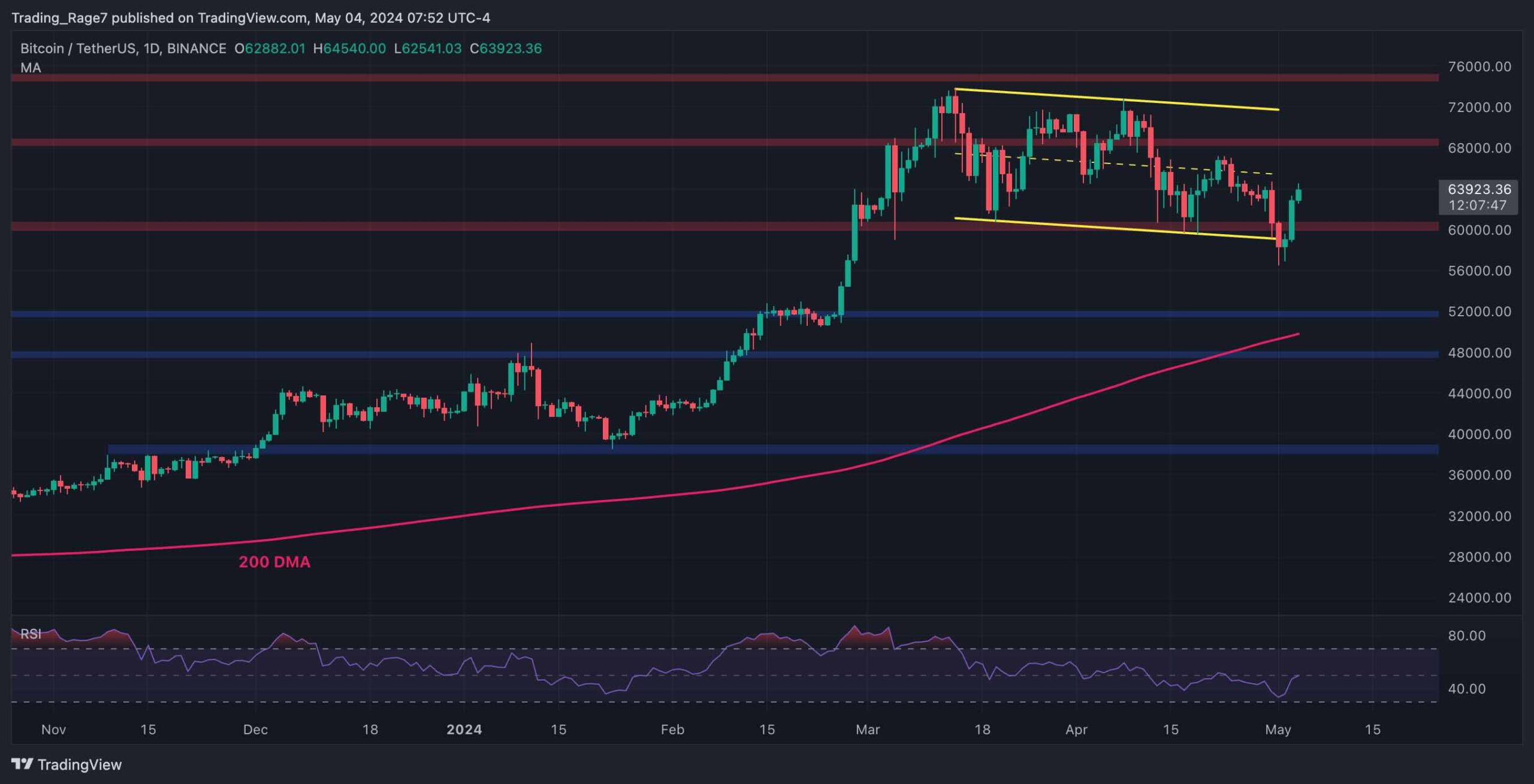
Bitcoin’s price has been going through some major moves throughout the past couple of weeks. The bulls are fighting to reestablish their dominance, staging a convincing recovery above $60K. But will it last?
Technical Analysis
By TradingRage
The Daily Chart
The price has been oscillating inside a descending channel on the daily chart for the past couple of months. The channel was briefly broken to the downside a few days ago.
However, BTC quickly rebounded and climbed back inside the channel, making a fake bearish breakout. With the $60K level also turning into support, the price will likely target the $68K resistance level in the short term.
The 4-Hour Chart
Looking at the 4-hour chart, it is evident that the price has quickly recovered from below the channel and the $60K level. The midline of the descending channel is now the next target.
Meanwhile, with the RSI approaching the overbought zone, the price might experience a pullback soon. The continuation of the bullish trend is dependent on whether the price can finally break the channel to the upside.
On-Chain Analysis
By TradingRage
Bitcoin Miners Position Index
While Bitcoin’s price has been trading below the $75K level, many market participants have been offloading their coins as they assume that the bull market might be over or a much deeper pullback is probable. However, miners are not in this group.
This chart demonstrates the Miners Position Index (MPI) metric. It measures miners’ selling pressure. Values above 2 can be considered dangerous, as they show massive destruction by the miners.
As the chart depicts, the MPI has been dropping rapidly over the last few months. This is a good sign, as the Miners’ selling pressure is declining. Thus, with sufficient demand, Bitcoin’s price can once again begin a rally toward $80K and even higher prices.
LIMITED OFFER 2024 for CryptoPotato readers at Bybit: Use this link to register and open a $500 BTC-USDT position on Bybit Exchange for free!
Disclaimer: Information found on CryptoPotato is those of writers quoted. It does not represent the opinions of CryptoPotato on whether to buy, sell, or hold any investments. You are advised to conduct your own research before making any investment decisions. Use provided information at your own risk. See Disclaimer for more information.
Cryptocurrency charts by TradingView.
Cryptocurrency
Coinbase Q1 Revenue Hit $1.6 Billion Amid ETF Approvals, Surging 72%
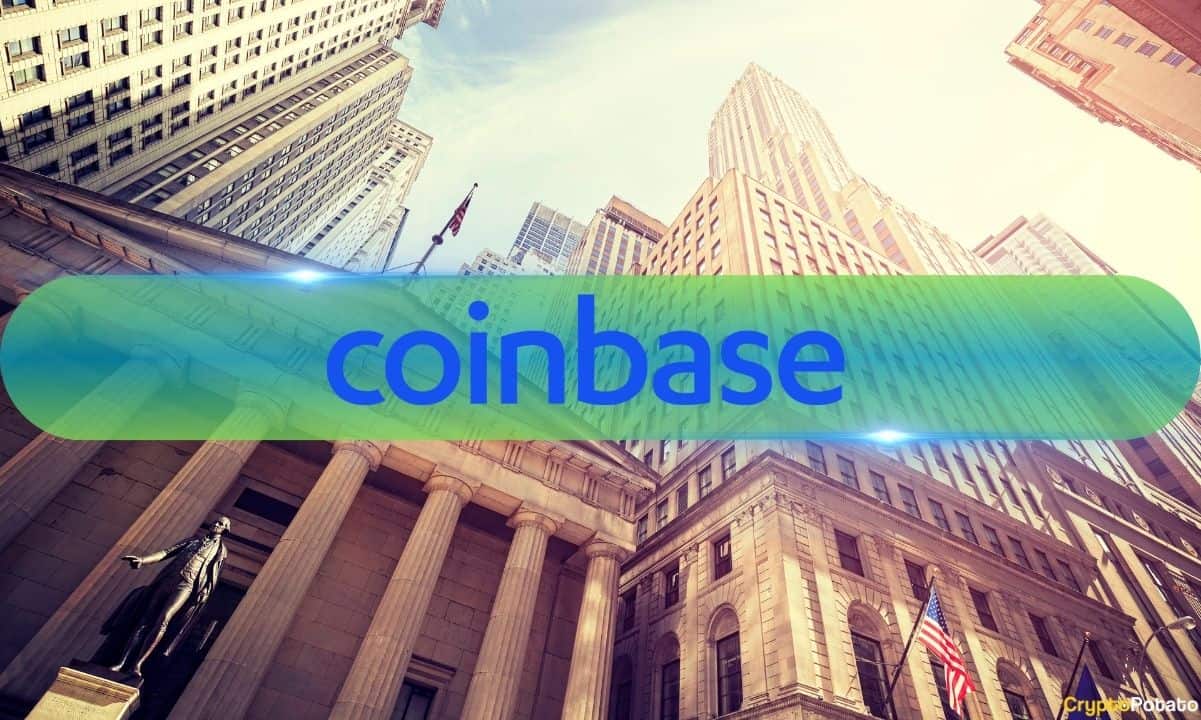
Coinbase, the largest U.S. crypto exchange, has released its Q1 2024 earnings report, posting a total revenue of $1.6 billion, a 72% increase quarter on quarter.
The performance has been driven by the rising crypto asset prices and the launch of spot Bitcoin ETFs in the U.S. which further improved inflows into the market.
Coinbase Earnings Surged in Q1
Coinbase’s net income reached $1.18 billion, $4.40 per share, translating to $1 billion in adjusted EBITDA in Q1. Comparatively, the adjusted EBITDA, which shows earnings before tax, depreciation, interest, and amortization, was $977.5 million in 2023.
Our Q1 2024 earnings report just dropped onchain.
Mint the latest $COIN Earnings NFT.
→ https://t.co/QhsV4V8TyiThen, head to coinbaseshop․com to unlock 20% off sitewide. pic.twitter.com/ngwChcmtJs
— Coinbase 🛡️ (@coinbase) May 2, 2024
The earnings report also showed that Coinbase attributed its net income partly to $737 million in pre-tax unrealized gains on crypto assets. The firm ended the quarter with $7.1 billion in capital, including $1.1 billion in net cash raised through the sale of 2030 convertible notes.
Consumer transaction revenue doubled to $935.2 million, and volume mirrored this, growing 93% to $56 billion. Institutional interest increased as well with transactions gaining revenue of $85 million, a 133% increase quarter on quarter. Meanwhile, the Coinbase Prime trading volume grew 105% to $256 billion, surpassing the U.S. spot market. Notably, Bitcoin accounted for a third of consumer and institutional transactions.
Coinbase’s custodial services revenue jumped 64% to $32 million. The surge was driven by the launch of spot Bitcoin ETFs earlier in the year since Coinbase is the custodian of eight of the eleven newly launched products. Assets under custody hit $171 billion as the quarter came to an end.
Coinbase’s Base Revenue Soars, Expenses Surge
Since its August launch, Base, Coinbase’s Ethereum layer 2 chain, has amassed $56.1 million in revenue. It has exhibited double the transaction volume compared to Ethereum, alongside an 800% surge in developer activity.
During the quarter, Coinbase acquired a minority stake in Circle, the issuer of USDC stablecoin, whose market capitalization increased by 30%. This boosted subscriptions and services revenue by a third, including a 15% increase in stablecoin revenue.
Despite diversification with Base and USDC, the recent boom was due to favorable market conditions. Bitcoin’s price skyrocketed 57% to an all-time high of $73,000, fueled by over $50 billion entering 10 spot Bitcoin ETFs approved in January.
Meanwhile, the company’s transaction expenses increased by 73% to $217 million. Due to increased trading volume, the company expects even higher costs in Q2, as high as $890 million.
LIMITED OFFER 2024 for CryptoPotato readers at Bybit: Use this link to register and open a $500 BTC-USDT position on Bybit Exchange for free!
Cryptocurrency
Is the Ethereum Bull Market Back or is Another Dip Below $3K Imminent? (ETH Price Analysis)
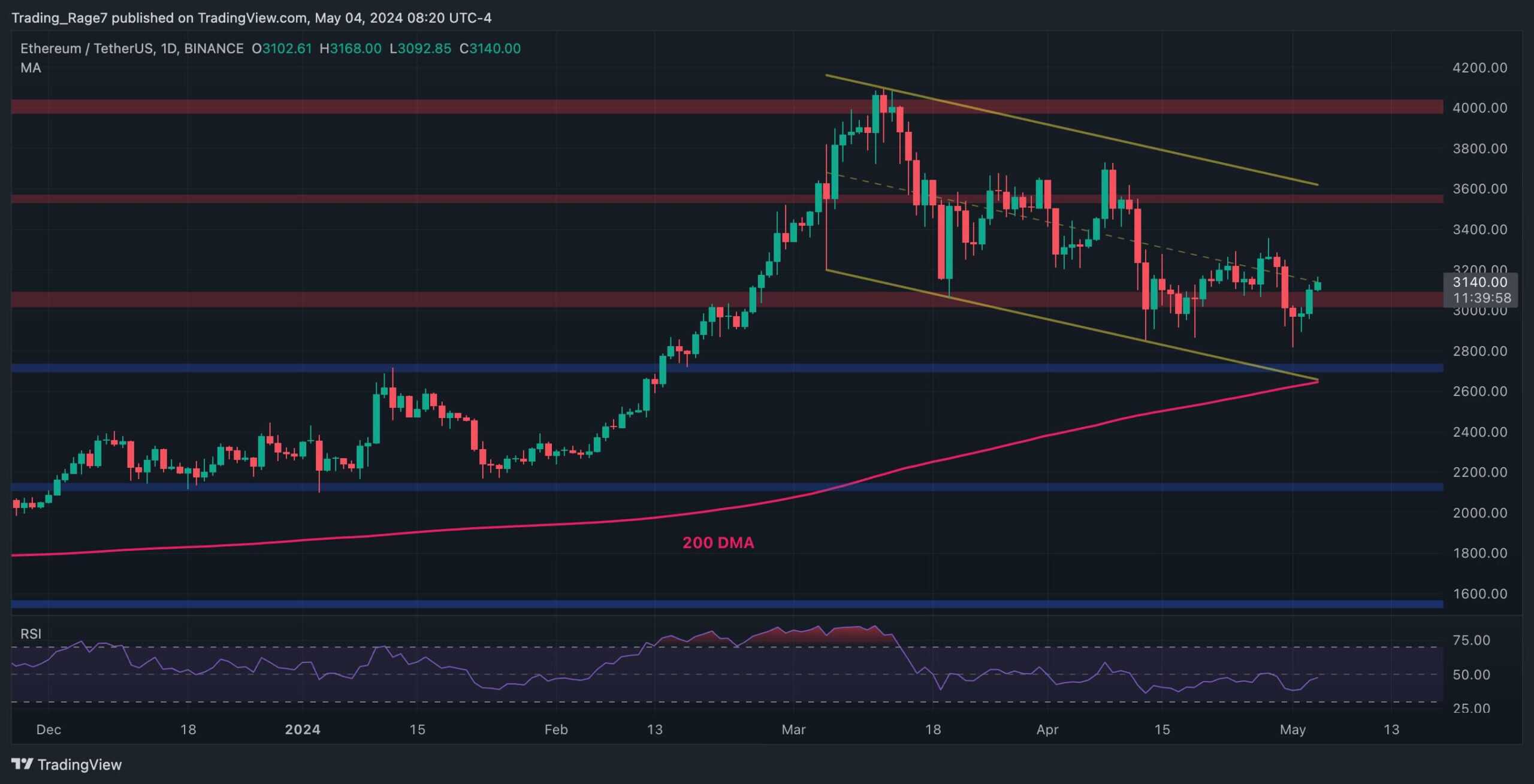
Ethereum’s price is yet to continue its uptrend following a rejection from the $4,000 resistance level. But the bulls are now showing signs of strength, perhaps staging a more considerable recovery.
Technical Analysis
By TradingRage
The Daily Chart
As the daily chart depicts, Ethereum’s price has been making lower highs and lows inside a descending channel since failing to break above the $4,000 resistance level.
Yet, the cryptocurrency is climbing back above the $3,000 level and the midline of the channel. If the market successfully recovers back to these levels, a breakout above the channel and a continuation toward $4,000 and even higher prices can be expected.
The 4-Hour Chart
The 4-hour chart offers a much clearer picture of recent price action. The market has barely broken through the $3,000 resistance zone and is currently testing the midline of the descending channel.
With the RSI showing values above 50%, ETH is likely to break through the level and potentially continue outward to the $3,600 resistance area. In this case, market participants can be optimistic that a new bullish wave will begin soon.
Sentiment Analysis
By TradingRage
Ethereum Funding Rates
Following the recent decline in Ethereum’s price, many futures traders have been liquidated or reversed their long positions. This can be a good sign, as the futures market has seemingly cooled down.
This chart demonstrates the Ethereum funding rates metric, which measures whether buyers or sellers are executing their futures orders more aggressively (using market orders). Positive values point to bullish sentiment, while negative ones show bearish expectations.
It is evident that the funding rates have significantly dropped compared to a couple of months ago. Low but positive funding rates can be interpreted as a bullish signal, as they show that while the futures market is not overheated anymore, the demand is still there, and the price can soon rally higher.
LIMITED OFFER 2024 for CryptoPotato readers at Bybit: Use this link to register and open a $500 BTC-USDT position on Bybit Exchange for free!
Disclaimer: Information found on CryptoPotato is those of writers quoted. It does not represent the opinions of CryptoPotato on whether to buy, sell, or hold any investments. You are advised to conduct your own research before making any investment decisions. Use provided information at your own risk. See Disclaimer for more information.
Cryptocurrency charts by TradingView.

 Forex2 years ago
Forex2 years agoForex Today: the dollar is gaining strength amid gloomy sentiment at the start of the Fed’s week

 Forex2 years ago
Forex2 years agoHow is the Australian dollar doing today?

 Forex1 year ago
Forex1 year agoUnbiased review of Pocket Option broker

 Forex2 years ago
Forex2 years agoDollar to pound sterling exchange rate today: Pound plummeted to its lowest since 1985

 Cryptocurrency2 years ago
Cryptocurrency2 years agoWhat happened in the crypto market – current events today

 World2 years ago
World2 years agoWhy are modern video games an art form?

 Stock Markets2 years ago
Stock Markets2 years agoMorgan Stanley: bear market rally to continue

 Economy2 years ago
Economy2 years agoCrude oil tankers double in price due to EU anti-Russian sanctions









